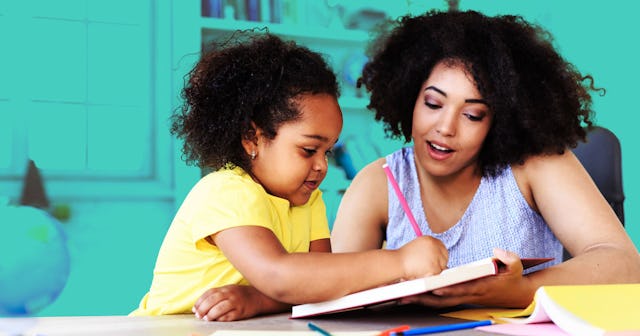The Pervasive Learning Myths We Need To Ditch In 2021

When the pandemic brought our worlds to a screeching halt in March 2020, we were forced to re-evaluate how we live, work, and spend our free time. In most cases, we adapted quickly, smoothed out the rough edges, and figured out how to pivot to a virtual existence. Unfortunately, one area didn’t transition smoothly: education.
As many of us know all too well, schools did not adapt to a virtual existence as well as other industries. Students (and parents) were left floundering. The reasons for the failure are numerous. We’d be hard pressed to find a single factor on which to lay blame, but one factor stands out among the many. It’s the one that speaks to the problem at the heart of our learning systems in general.
It’s the fact that educators and administrators still subscribe to myths and misconceptions about the way children learn, even though neuroscience has disproved many of those traditionally held beliefs.
Scary Mommy spoke with educational neuroscientist Rudy Silva Mera about commonly held education misconceptions that still shape how we understand learning and what we can do to bring education into the twenty-first century.
Educational Misconceptions Persist Despite Neuroscience
We’ve all heard of learning styles. We’ve all probably identified our personal learning styles, too. For example, in the past, I would have identified myself as a visual learning. I’d have said, and believed, that I learn better when I can see or read the material being presented.
As it turns out, according to Silva Mera, learning styles don’t exist—not in the way we know them. There’s even research debunking this idea, and yet it persists in education. The false concept came from actual research finding that different kinds of information—visual, auditory, etc.—are processed in different parts of the brain. However, our brains are so “highly interconnected” that information is transferred between various “sensory modalities.” According to Silva Mera, we have learning preferences, ways we prefer to learn, but that has nothing to do with a learning style.
Other educational misconceptions exist, as well. They include believing that children are either left-brained or right-brained, that we only use 10 percent of our brain, that certain foods impact how well our brains work, and there are multiple intelligences.
Problem With Letting These Myths Persist
These misconceptions can seem harmless on the surface. In reality, however, they’re entering the classroom and impacting how educators are educating. Schools waste “money, time, and effort, which could be better spent on the development of evidence-based practices,” according to a study published in 2012.
Where this is most obvious is in the way we evaluate students. Right now, most schools use testing to evaluate progress. We ask students to learn and then explain what they learned. That’s not the best way, according to Silva Mera. He points to an experiment in which children ages 3-12 were asked to perform a scientific task and then explain it. The children performed the task well, but struggled to explain it. This experiment suggests that testing is not the best way to evaluate performance—and yet testing persists.
Failing to put neuroscience into practice in the classroom is creating a “huge crisis about the way we’re learning,” says Silva Mera. If there’s anything we’ve learned this past year, it’s the importance of listening to science.
Tang Ming Tung/Getty
Moving Education Into The Future
Although the conservative values our educational system is based on have allowed us to have solid institutions that have existed for many years, “in terms of adaptability and evolution, it hasn’t worked out well.”
“Education needs to be experiential,” according to Silva Mera. “When we think about the best learning experiences that we’ve had in our lives, they’re immersive; it’s an environment of education.” Think of a beautiful trip or a museum. Silva Mera even points to Disney World as an example of an environment that is conducive to learning; it’s entirely immersive.
He highlights that children learn better when they know there’s “utility and meaning” in the things they’re learning.
Silva Mera also encourages educational systems to look to research about engagement on social media. Digital journalism, TikTok, YouTube are all adept at engaging their users. He believes education can adapt some of that research (while also balancing risk factors about diminishing attention spans and screen addiction) to help children learn in a way that keeps them engaged. He’d love to see education “accomplish what a ten-second tutorial on TikTok accomplishes.”
Education Needs To Evolve In 2021
It’s certainly a lot of work, especially considering that long-held beliefs are often slow to evolve. But just because something is a lot of work doesn’t mean it’s not worthwhile. When it comes to our kids, if we can do better, we should do better.
The takeaway point is twofold. One, relax. Parents should “chill out” about the “lost” education of this past pandemic year. He notes that children have their whole lives to learn math, and research affirms that the most successful managers are those with social and emotional intelligence.
Two, he urges educators (and parents and administrators) to learn how the brain works. The way physicians must learn anatomy to practice medicine, teachers must learn about the brain in order to teach.
The last year has proven how important science is in making decisions. It’s also shown us that just because something has always been done one way, it doesn’t need to continue that way. That’s particularly true when circumstances make the old way impossible, as in the pandemic. It’s long past time that education rejects the misconceptions that aren’t helping our kids. It’s time we find a way to bring learning into the twenty-first century.
This article was originally published on